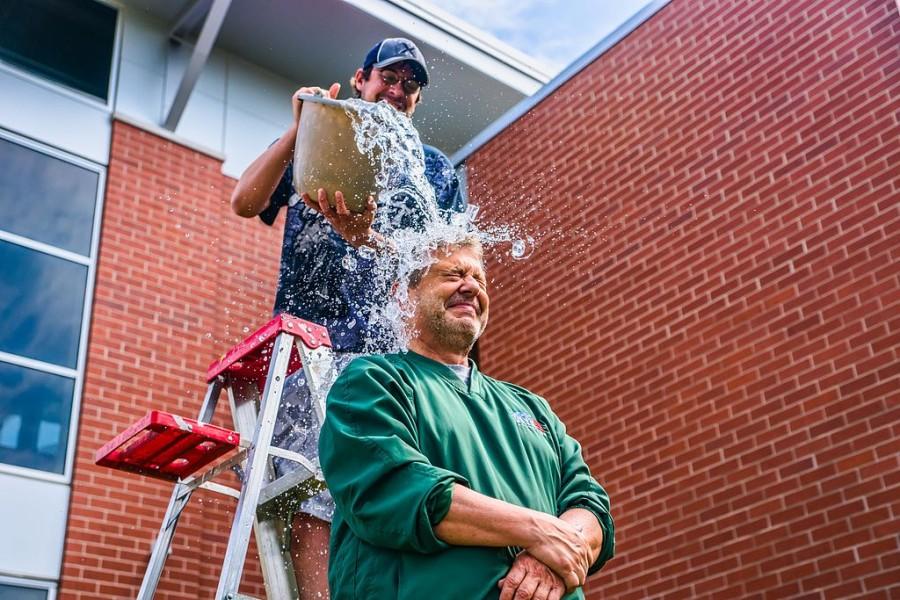Ice bucket challenge lives on
Since The Talon’s recent blog post on the subject, the “Ice Bucket Challenge” is still going strong in social media. The challenge has become viral in the past few weeks and even celebrities and famous figures such as Bill Gates, Lionel Messi, Taylor Swift, and former U.S. President George W. Bush have taken part of this movement to raise awareness for amyotrophic lateral sclerosis (ALS), also known as Lou Gehrig’s Disease.
This fad began to catch on when professional golf player, Chris Kennedy, filmed himself doing the ice-bucket challenge in mid-July and challenged three others to do the same. Chains of those who were challenged led to Boston College baseball captain Pete Frates, who then challenged fellow athletes and celebrities. Afterwards, what we now know as the ALS Ice Bucket Challenge began to receive more attention.
Donations are encouraged, and are made to the ALS Association, a non-profit organization whose mission as stated on their website is to “[lead] the fight to treat and cure ALS through global research and nationwide advocacy while also empowering people with Lou Gehrig’s Disease and their families to live fuller lives by providing them with passionate care and support.”
As of Thursday, August 21, the organization said that it has received $41.8 million from July 29 to August 21. In the same time frame last year, just $2.1 million in donations were made. According to the Association, there have been 739,275 new donors recently. Donations made are used towards the global medical research for a cure for the disease.
The challenge is raising awareness in the Graded community as well. Sophomore Fe Sayao stated that the Ice Bucket Challenge helped her learn about the disease. “It was a good way to raise awareness of the disease and it was a fun learning experience,” she said. Senior Maria Isabel Guinle remarked, “At first, I thought it was pointless, but when I researched about the campaign and how much money it had raised, I realized it was purposeful.”
However, with the rising popularity of the challenge, some students have raised concerns regarding the lost motive of the project. Senior Laura Schivartche said, “I think the motive behind it was good, but now it’s an everyone-doing-it thing. People are forgetting the reason it all started.” Senior Aline Ho adds, “People just want to have fun and they don’t have the intention to help the cause—many people just do it for the fun.”
Guinle believes that the “fun” aspect of the challenge is greater than knowing what exactly the Lou Gehrig’s Disease is. Schivartche also stated that not many people know what the disease is, but the challenge has helped to raise awareness, saying, “No one is finding out what ALS is, but it’s getting people to know that there’s a disease out there, a disease that needs research funding.” Ho raises a concern about the current water shortage here: “I think it’s a waste of water, especially in Brazil where lack of water is a big problem.”
Sayao additionally states that while the challenge has effectively raised awareness for Lou Gehrig’s Disease, other diseases have not received the same attention as ALS. “I was thinking about the Challenge, and there’s so many diseases out there that we had no idea about. I thought this movement was good, but I felt that we were giving attention to the ALS disease only….I was disappointed that we haven’t give, as much attention to other diseases like cancer or Alzheimer’s.”
Overall, Graded students agree that money donations are an effective way to directly support the cause. Guinle said, “I think people are focusing too much on just doing it for fun and not knowing what ALS is, but if that still gives money to the cause, I think it’s legit.” Ho added, “ I think people do [the challenge] because they think they’re helping the organization, and they feel good by helping, but they’re not helping if they’re not actually donating.”
Sources: nytimes.com, alsa.org, dailymail.co.uk

Julia, also known as ‘Joules’ (yes, that unit for energy), is new to The Talon this year and will be working as the News Editor. She is an excellent...











Sandra McDonnell • Aug 29, 2014 at 1:33 pm
Mrs. Engstrom did a great job with her 4th grade students. First of all, she introduced the problem to the kids and explained the Ice Bucket Challenge. Children came home with a letter and a lot of new words explaining the parents what they learned about ALS and the challenge they were up to embrace. In the following day, those who wanted to participate had the opportunity to do it. I think it was a wonderful way to raise awareness about a social cause and to learn that, most of times, we have the power to improve things. It all depends on taking part. And, God, it was such a sunny day!